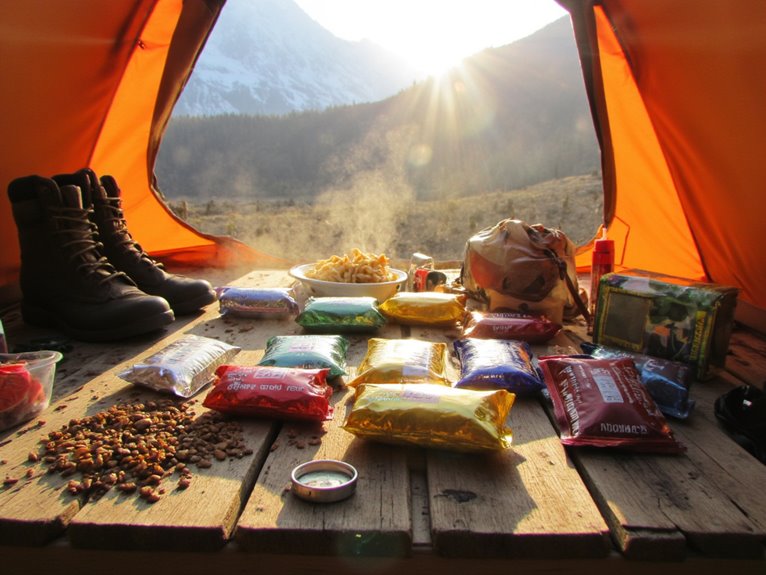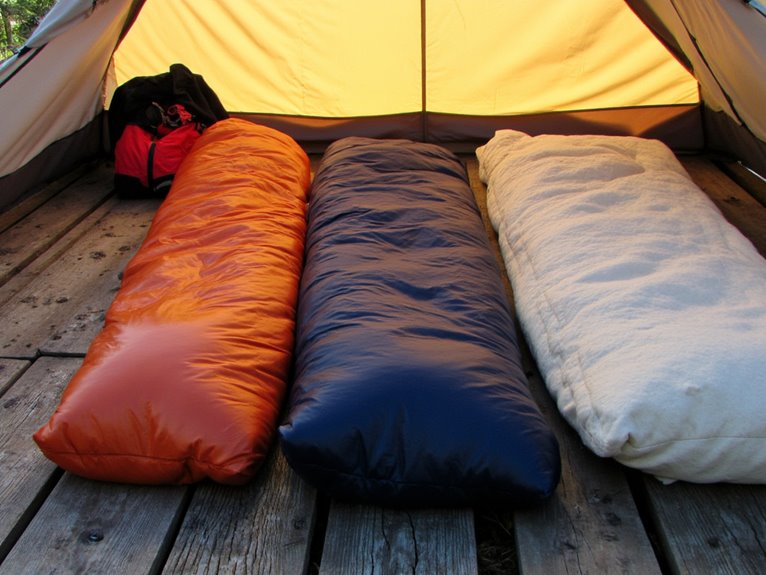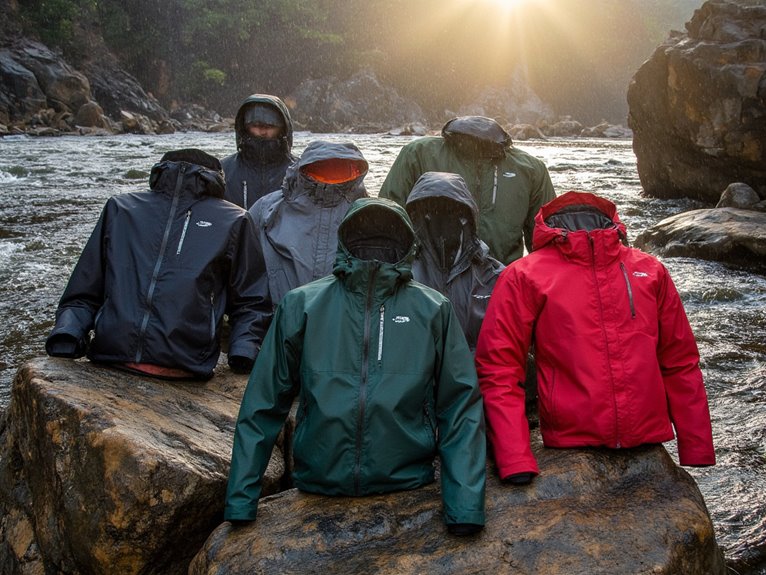10 Best Sleeping Bags for Backpacking That Won’t Weigh You Down
I’ve found that the best ultralight sleeping bags balance weight and warmth through strategic insulation choices. Down-filled options like the 600 fill power models compress to water bottle size while weighing just 1.5-2 pounds, compared to 4+ pound budget alternatives. For three-season backpacking, I recommend bags rated 10-15°F below expected conditions, with 400T ripstop nylon shells for durability. The TETON LEEF, ECOOPRO, and quality down bags consistently perform across multiple seasons, though each excels in specific temperature ranges and user requirements that warrant closer examination.
We are supported by our audience. When you purchase through links on our site, we may earn an affiliate commission, at no extra cost for you. Learn more. Last update on 24th December 2025 / Images from Amazon Product Advertising API.
Notable Insights
- Prioritize ultralight sleeping bags under 2 pounds with down insulation offering superior warmth-to-weight ratios and compression.
- Choose bags with 400T ripstop nylon shells and 600+ fill power down for durability without sacrificing weight.
- Select temperature ratings 10-15°F below expected conditions, focusing on bags effective between 40°F-60°F for three-season use.
- Look for compression sacks that reduce packed size by 40%, ideally compressing to water bottle dimensions.
- Invest in quality bags with 3-5 year warranties despite higher upfront costs for better long-term value.
Down Sleeping Bag for Adults, 600 Fill Power with Compression Sack
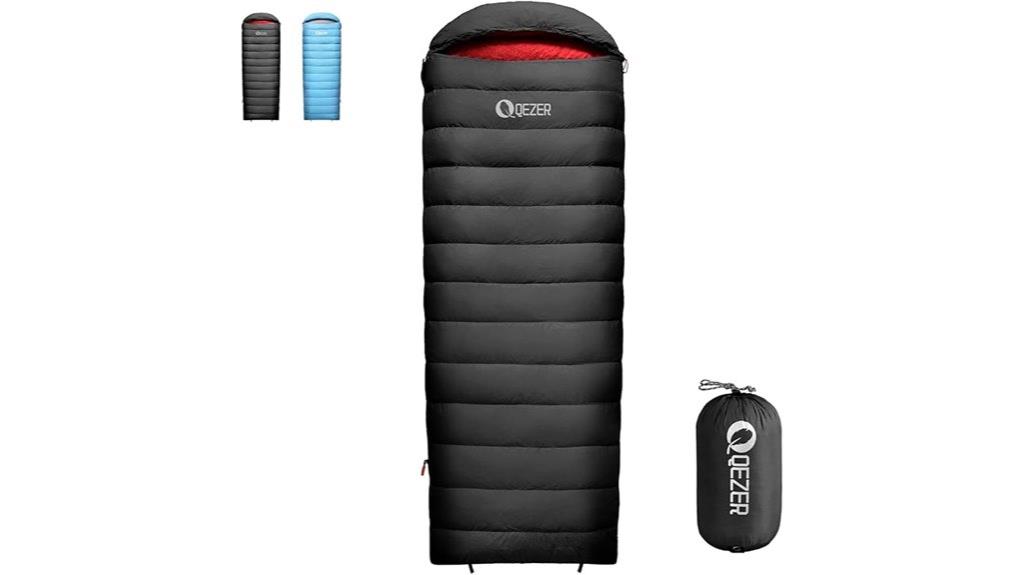
The QEZER down sleeping bag targets ultralight backpackers who prioritize weight savings without sacrificing warmth in moderate conditions. You’ll appreciate its 600 fill power duck down insulation that keeps you comfortable in temperatures between 59°F and 68°F, with a lower limit of 45°F. The bag weighs just 1.54 pounds and packs down to 10.6 x 5.5 inches using the included compression sack.
The semi-rectangular design measures 30.7 x 82.7 inches, accommodating campers under six feet tall. You’ll find the 400T 20D nylon shell provides tear resistance and moisture protection, while dense stitching prevents down migration. The double zipper system and chest insulation enhance thermal efficiency for three-season backpacking adventures.
Best For: Ultralight backpackers and hikers under 6 feet tall who need a compact, lightweight sleeping bag for three-season camping in moderate temperatures above 50°F.
Pros:
- Ultralight at just 1.54 lbs with excellent packability (10.6 x 5.5 inches when compressed)
- Quality 600 fill power duck down insulation with double zipper design and chest insulation for effective warmth retention
- Durable 400T 20D nylon construction with moisture-proof and tear-resistant properties plus dense stitching to prevent down leakage
Cons:
- Limited size accommodation as it’s only suitable for campers under 6 feet tall and slender individuals
- Temperature range is restrictive with comfort ratings only between 59°F-68°F and not suitable below 45°F
- Some user concerns about outer fabric durability despite the high-density nylon construction
ATEPA Ultralight Sleeping Bag for Adults with Stuff Sack
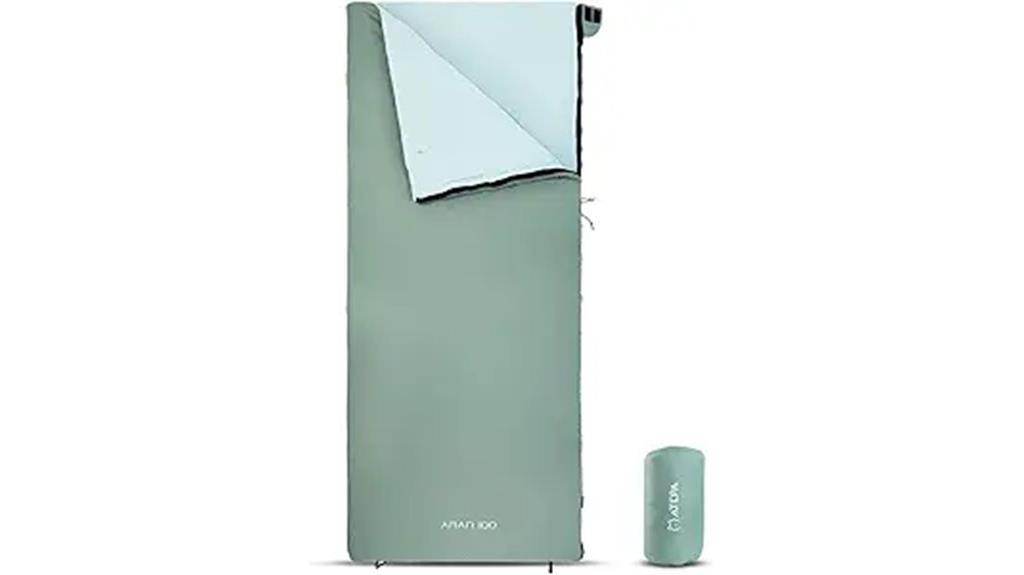
ATEPA’s Ultralight Sleeping Bag stands out as an exceptional choice for weight-conscious backpackers who prioritize versatility without sacrificing warmth. At just 1.51 pounds, it compresses to 7.09×12.99 inches—smaller than a standard water bottle. You’ll appreciate the 3-in-1 design that converts between sleeping bag, blanket, or quilt configurations.
The 20D 380T ripstop nylon construction provides water resistance while maintaining durability. Two-way zippers enable leg ventilation without heat loss. Draft tubes and contoured hood minimize cold spots, while 100g/m² silk-imitation fiberfill delivers thermal efficiency to 50°F. The reinforced compression sack saves 40% more pack space than traditional bags for multi-day adventures.
Best For: Weight-conscious backpackers and hikers who need a versatile, compact sleeping solution for warm weather camping and multi-day treks.
Pros:
- Exceptionally lightweight at 1.51 lbs and compresses smaller than a water bottle for ultralight backpacking
- Versatile 3-in-1 design converts between sleeping bag, blanket, or quilt with two-way zippers for temperature control
- Durable 20D ripstop nylon construction with water-repellent finish and thoughtful features like draft tubes and hidden storage pocket
Cons:
- Limited to warm weather use with thermal efficiency only down to 50°F (10°C)
- Synthetic insulation may not provide the same warmth-to-weight ratio as premium down alternatives
- Compact size may feel restrictive for larger individuals or those who prefer more room to move while sleeping
Lightweight Waterproof Sleeping Bags for Adults Backpacking
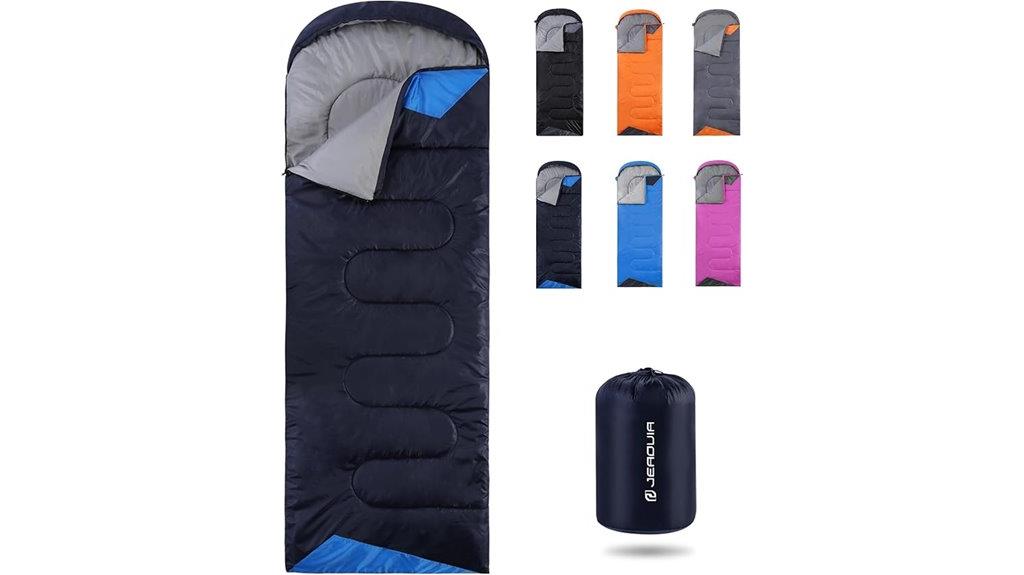
Backpackers who prioritize weight savings without sacrificing weather protection will find this sleeping bag delivers exceptional value at 3.3 pounds. The 100% polyester outer shell provides waterproof, breathable protection while maintaining a compact 7.9 to 14.2-inch compressed size.
You’ll stay comfortable in temperatures ranging from 50℉ to 68℉, with recommended limits extending from 41℉ to 77℉. The 31.5 by 86.6-inch dimensions accommodate campers up to 5’11”. The drawstring hood retains warmth while the foot zipper regulates airflow when needed.
The polyester pongee lining and hollow cotton filling create a comfortable sleep system that’s easy to clean and pack. With 4.5 stars from nearly 10,000 customers, this #2-ranked camping sleeping bag proves reliable for three-season adventures.
Best For: Casual backpackers and campers who need a lightweight, waterproof sleeping bag for three-season use in moderate temperatures and want reliable performance without breaking the budget.
Pros:
- Lightweight at 3.3 pounds with compact compression size (7.9-14.2 inches) ideal for backpacking
- Waterproof and breathable polyester outer shell provides excellent weather protection
- Versatile temperature range (41℉-77℉) with functional features like drawstring hood and foot zipper
Cons:
- Limited size accommodation (only fits campers up to 5’11”) may exclude taller users
- Some users report zipper durability issues over time
- Not suitable for cold weather camping below 41℉ temperature rating
Teton 20F and 5F Degree Lightweight Mummy Sleeping Bag
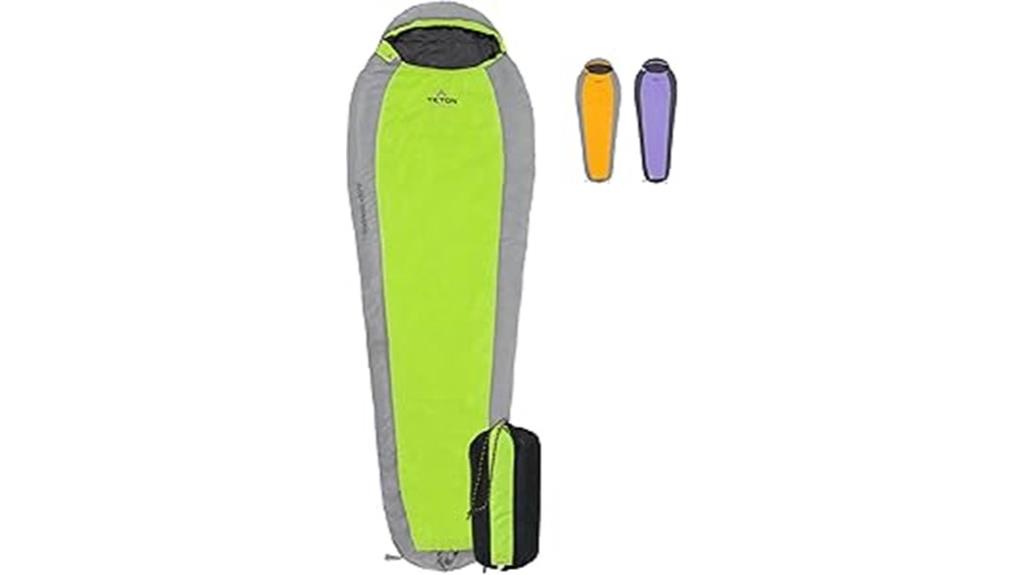
Ultralight backpackers seeking reliable three-season protection will find exceptional value in Teton’s 20F and 5F degree mummy sleeping bags. These microfiber-insulated bags deliver exceptional warmth-to-weight ratios for extended wilderness trips.
The mummy design eliminates heat loss through form-fitting hoods that seal around your head and face. Zipper draft tubes prevent cold air infiltration along the closure. Vaulted footboxes provide extra insulation where you need it most.
You’ll appreciate the innovative microfiber insulation that maintains excellent loft while compressing efficiently. The included compression sack reduces pack volume considerably—start stuffing from the bottom and cinch the heavy-duty straps tight. Hang loops preserve maximum loft during long-term storage between adventures.
Best For: Ultralight backpackers and hikers who need reliable three-season warmth without carrying excessive weight on extended wilderness trips.
Pros:
- Excellent warmth-to-weight ratio with innovative microfiber insulation that maintains loft while compressing efficiently
- Mummy design with form-fitting hood, zipper draft tubes, and vaulted footboxes eliminates heat loss and cold air infiltration
- Includes compression sack for reduced pack volume and hang loops for proper long-term storage
Cons:
- Mummy design may feel restrictive for side sleepers or those who move frequently during sleep
- Microfiber insulation may not provide the same durability as down insulation over many years of use
- Limited temperature rating options with only 20F and 5F versions available
Naturehike Lightweight Sleeping Bag – Compact, Ultralight, Envelope Backpacking Bag
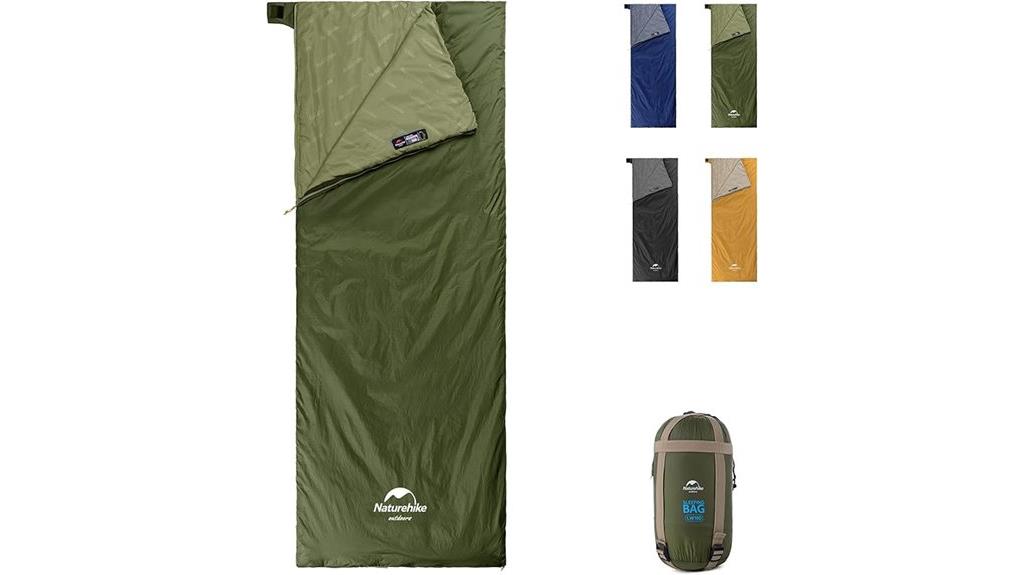
Summer backpackers seeking maximum portability will find the Naturehike Lightweight Sleeping Bag delivers exceptional weight-to-comfort ratios for warm-weather adventures. At 815 grams, it compresses to Nalgene bottle size with an integrated strap system. The envelope design accommodates side sleepers up to 6’0″ comfortably.
You’ll get reliable performance above 60°F, but don’t trust manufacturer temperature ratings below 55°F. Users report discomfort at 40°F without additional layers. The waterproof exterior and quality zipper handle three-season conditions effectively.
This bag excels for summer trekking above 10°C where weight matters most. It’s unsuitable for high-altitude or cold-weather expeditions but offers excellent value for warm-weather backpacking applications.
Best For: Summer backpackers and warm-weather campers who prioritize ultralight gear and need a compact sleeping bag for temperatures above 60°F.
Pros:
- Exceptionally lightweight at 815 grams and compresses to the size of a Nalgene bottle for maximum portability
- Comfortable envelope design that accommodates side sleepers up to 6’0″ with good roominess and loft
- Excellent value with quality construction including waterproof exterior and reliable zipper system
Cons:
- Inadequate insulation for temperatures below 55-60°F, limiting use to warm weather only
- Manufacturer temperature ratings are unreliable and overly optimistic for actual comfort levels
- Unsuitable for high-altitude or cold-weather expeditions where additional warmth is critical
FARLAND Sleeping Bags 30℉ for Adults with Compression Sack
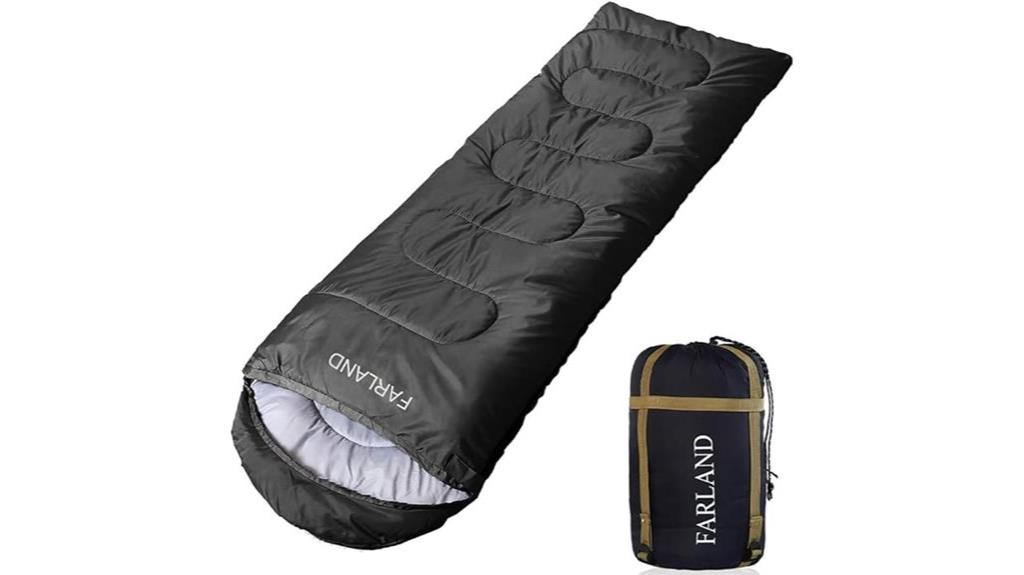
The FARLAND 30℉ sleeping bag targets budget-conscious adventurers who need reliable warmth for three-season camping without breaking the bank. You’ll get two shape options: envelope (29.5 x 86.6 inches) or mummy (33.5 x 86.6 inches). The 290T nylon exterior provides waterproof protection while polyester pongee lining adds comfort.
At 4.5 pounds, it’s heavier than ultralight options but includes practical features like roll control design and compression sack. The 400GSM polyester fill delivers warmth in 20-62℉ conditions. You can zip two bags together for couples camping. Internal storage pouch keeps essentials accessible. With 4.3/5 stars from 5,473 reviews, performance matches the affordable price point.
Best For: Budget-conscious campers and outdoor enthusiasts who need a reliable 3-season sleeping bag with decent warmth retention and versatile features for car camping, hiking, and backpacking adventures.
Pros:
- Versatile design with two shape options (envelope and mummy) that can zip together for couples, plus practical features like internal storage pouch and compression sack
- Affordable price point with solid construction including waterproof 290T nylon exterior and 400GSM polyester fill for reliable warmth in 20-62℉ conditions
- Strong customer satisfaction with 4.3/5 star rating from over 5,400 reviews and 100% risk-free satisfaction guarantee
Cons:
- At 4.5 pounds, it’s significantly heavier than ultralight alternatives, making it less ideal for long-distance backpacking
- Some quality control issues reported in reviews, particularly with stitching durability and stuff sack construction
- May not perform reliably at the lower end of its temperature rating without additional insulation like a sleeping pad
Ultralight Down Sleeping Bag – 650 Fill Power for Backpacking & Camping
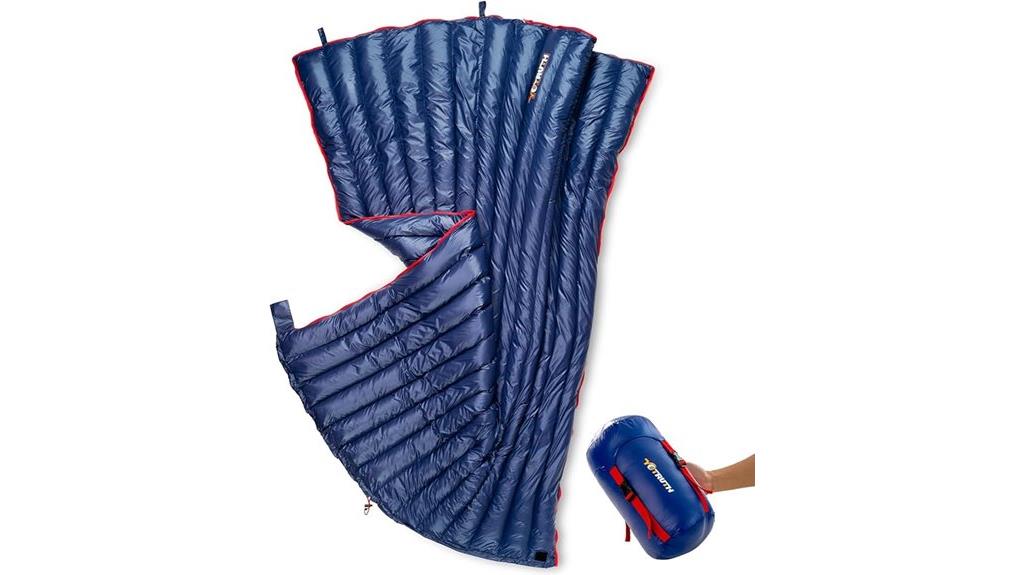
Weighing just 27 ounces, this Yotruth sleeping bag targets backpackers who prioritize pack weight without sacrificing warmth in moderate conditions. The 650 fill power duck down provides insulation for temperatures between 35-50°F, making it ideal for three-season use.
You’ll appreciate the 400T ripstop nylon shell that’s both water-repellent and tear-resistant. The YKK anti-snag zipper guarantees reliable operation during extended trips. When packed, it compresses to 18 x 18 x 32 centimeters.
The sleeping bag converts into a blanket when fully unzipped and transforms into a wearable cape using integrated buttons. At 75 x 28 inches, it offers spacious dimensions for comfortable sleep. However, you’ll need additional insulation for truly cold conditions since it lacks a hood and insulated foot box.
Best For: Three-season backpackers and campers who need an ultralight sleeping bag for moderate temperatures (35-50°F) and want the versatility of converting it into a blanket or wearable cape.
Pros:
- Extremely lightweight at just 27 ounces with excellent packability, making it ideal for weight-conscious backpackers
- Versatile design that converts into a blanket when unzipped or transforms into a wearable cape with integrated buttons
- Durable construction with 400T ripstop nylon shell, water-repellent coating, and reliable YKK anti-snag zipper
Cons:
- Limited to moderate temperatures (35-50°F) and not suitable for cold weather conditions
- Lacks essential cold-weather features like a hood and insulated foot box that reduce overall warmth retention
- Relatively new product with limited customer feedback (only 9 ratings) making long-term reliability uncertain
ECOOPRO Warm Weather Sleeping Bag – Portable, Waterproof & Lightweight
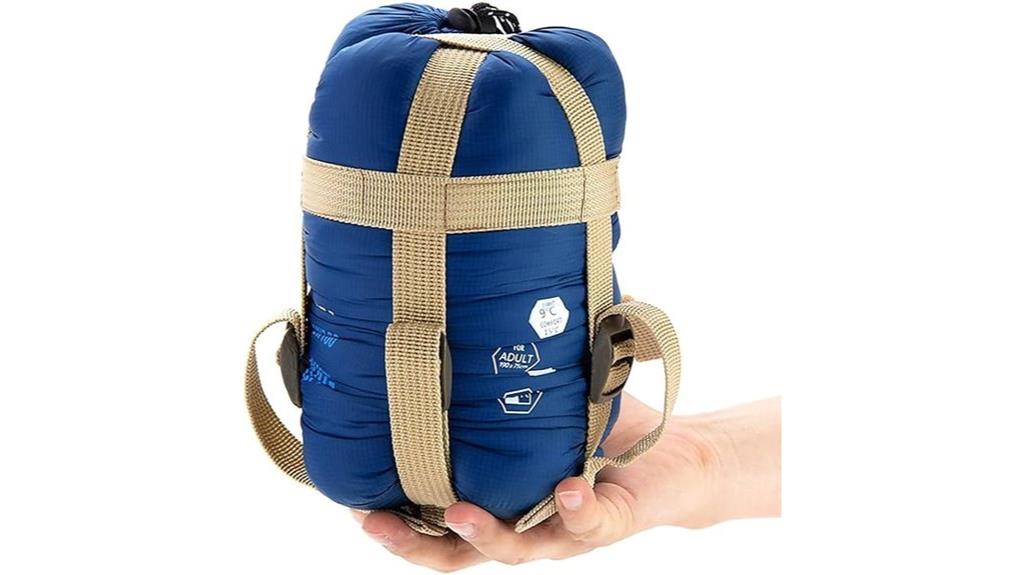
Ultralight backpackers seeking comfort in mild climates will find the ECOOPRO Warm Weather Sleeping Bag delivers exceptional portability at just 1.7 pounds. This envelope-style bag measures 83L x 30W inches and packs down to 11 inches tall, making it ideal for space-conscious hikers. The nylon outer shell provides water resistance against light precipitation, while the 100% polyester lining guarantees breathability.
You’ll appreciate its 55-60°F temperature rating for spring and summer adventures. The bag accommodates one adult comfortably, though users with broader shoulders may find the fit snug. It compresses efficiently into its stuff sack and maintains durability through repeated packing cycles, backed by a two-year manufacturer warranty for reliable backcountry performance.
Best For: Ultralight backpackers and hikers who need a compact, lightweight sleeping bag for warm weather camping in temperatures between 55-60°F.
Pros:
- Extremely lightweight at just 1.7 pounds and packs down to only 11 inches tall for maximum portability
- Water-resistant nylon shell with breathable polyester lining provides comfort in mild weather conditions
- Durable construction with easy compression and storage, backed by a 2-year manufacturer warranty
Cons:
- Limited waterproofing that only protects against light drizzle, not heavy rain or extreme weather
- Not suitable for cold weather camping below 50°F, restricting use to warm seasons only
- Snug fit may be uncomfortable for users with broader shoulders or those who prefer more room
MalloMe Sleeping Bags for Adults Cold Weather & Warm
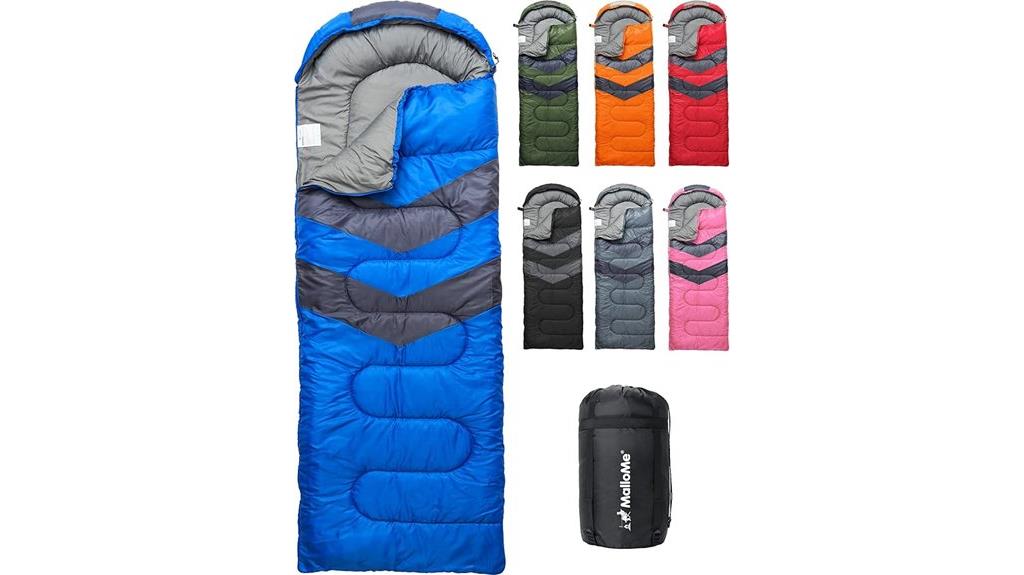
Year-round adventurers seeking versatile temperature performance will find the MalloMe Sleeping Bags for Adults deliver reliable comfort across three seasons with its 50°F to 77°F temperature rating. You’ll appreciate the rectangular design measuring 86.6L x 31.5W inches, accommodating adults up to 6 feet tall while maintaining a lightweight 3-pound profile.
The waterproof hex-tech outer shell protects against moisture while the 3D synthetic fiber fill provides consistent insulation. Double-sided zippers feature snag-free operation with velcro straps ensuring secure closure. You can adjust warmth using integrated drawstrings during temperature fluctuations.
The included compression sack maximizes packability for backpacking trips. Machine-washable construction simplifies maintenance between adventures.
Best For: Three-season campers, hikers, and backpackers who need a versatile, lightweight sleeping bag for temperatures between 50°F to 77°F and want easy maintenance with waterproof protection.
Pros:
- Versatile temperature rating (50°F-77°F) makes it suitable for spring, summer, and fall camping
- Lightweight at 3 pounds with compression sack for easy packing and transport
- Waterproof hex-tech outer shell with machine-washable design for simple maintenance
Cons:
- Some users report zipper durability issues with heavy use
- Storage bag quality receives complaints from customers
- Limited to adults up to 6 feet tall, excluding taller individuals
TETON Sports LEEF Ultralight Mummy Sleeping Bag for Backpacking & Camping
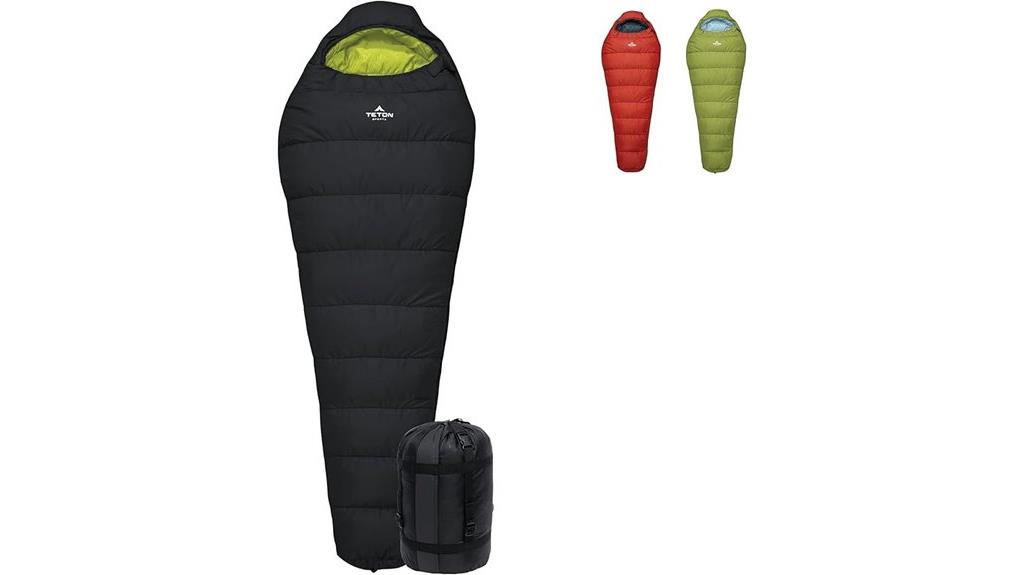
The TETON Sports LEEF Ultralight Mummy Sleeping Bag breaks the mold of traditional mummy designs by offering nearly four inches of extra width without sacrificing packability. You’ll find three temperature ratings available: 0°F, 20°F, and 30°F models. The bag comes in short, regular, and long sizes with more room than standard industry measurements.
Dual zippers provide ventilation control while soft brushed inner fabric enhances comfort. The external polyester construction guarantees durability during extended backcountry use. You’ll receive a compression sack included, though the compressed size remains larger than competitors.
TETON Sports backs this sleeping bag with a lifetime warranty covering material and workmanship defects.
Best For: Backpackers and campers who prioritize comfort and extra room over minimal pack size and don’t mind carrying a slightly bulkier sleeping bag.
Pros:
- Nearly four inches wider than typical mummy bags while maintaining mummy-style efficiency
- Available in three temperature ratings (0°F, 20°F, 30°F) and three sizes with generous dimensions
- Backed by lifetime warranty covering material and workmanship defects
Cons:
- Larger compressed size compared to competitors may not fit smaller backpack compartments
- Head hood sizing may be uncomfortable for users taller than 6’2″
- Initial entry can feel cold before the bag warms up
Factors to Consider When Choosing a Sleeping Bag for Backpacking
Choosing the right sleeping bag for backpacking requires careful evaluation of five critical factors that’ll determine your comfort and safety on the trail. I’ll walk you through temperature rating requirements, weight and packability constraints, insulation type differences, shape and size considerations, and material durability standards. Each factor directly impacts your pack weight, warmth retention, and overall backpacking experience in different conditions.
Temperature Rating Requirements
When you’re selecting a sleeping bag for backpacking, temperature rating becomes your most critical specification to evaluate. These ratings indicate the lowest temperature where you’ll maintain warmth, typically ranging from 20°F for cold-weather models to 68°F for summer bags.
You’ll encounter three distinct ratings. The comfort rating spans 59°F to 68°F for three-season bags, representing ideal sleep conditions. The limit rating identifies the coldest usable temperature, usually around 45°F, before you’ll feel cold. Most backpacking bags function effectively between 40°F and 60°F.
Your individual factors matter greatly. Body type, metabolism, and additional insulation like sleeping pads affect perceived warmth. I recommend selecting bags rated 10-15°F below expected conditions to account for these variables and guarantee comfortable sleep during temperature drops.
Weight and Packability
After temperature ratings, weight becomes your second most important consideration for backpacking sleeping bags. I’ve found that every ounce matters on multi-day hikes. The lightest options weigh just 1.51 lbs, like the ATEPA model, while heavier bags exceed 4 lbs and notably impact your pack weight.
Packability is equally vital. The best sleeping bags compress to water bottle size, maximizing your pack’s efficiency. Ultralight models from Yotruth and ECOOPRO weigh around 1.7 lbs while maintaining adequate insulation for warm conditions.
Look for compression sacks that reduce pack size by 40%. This feature transforms bulky gear into manageable loads. Well-constructed bags balance weight with insulation performance, ensuring you won’t sacrifice warmth for portability during extended outdoor adventures.
Insulation Type Comparison
While weight considerations matter considerably, your sleeping bag’s insulation type fundamentally determines its performance across varying conditions. Down insulation delivers exceptional warmth-to-weight ratios with superior compressibility. I recommend 600+ fill power for backpacking in cooler conditions, as higher ratings indicate better loftiness and insulation effectiveness.
Synthetic fills offer distinct advantages despite increased weight. They resist moisture and dry faster than down, maintaining insulation properties when wet. This makes synthetic options more reliable during variable weather.
Down excels in dry conditions with lighter weight and smaller packed size. However, it loses effectiveness when saturated. Synthetic insulation performs consistently in damp environments but requires more pack space. Your choice depends on expected weather conditions and weight priorities for your specific backpacking objectives.
Shape and Size
Your sleeping bag’s shape creates the foundation for thermal efficiency and packability on the trail. Mummy bags taper toward your feet, eliminating dead air space that steals precious heat. This design cuts weight and compresses smaller than rectangular alternatives. However, you’ll sacrifice freedom of movement for thermal performance.
Rectangular bags offer spacious comfort but carry weight penalties. They’re bulkier and create heat-robbing air pockets around your body.
Size selection demands precision. Most bags accommodate users up to 6 feet tall with proper fit guidelines. I recommend measuring your height and adding 4-6 inches for ideal coverage. Internal width matters equally—too tight restricts circulation and warmth, while excess space forces your body to heat unnecessary volume. Balance thermal efficiency with your sleeping style and gear storage needs.
Material and Durability
The fabric shell determines whether your sleeping bag survives years of trail abuse or fails after a few seasons. I recommend 400T ripstop nylon for maximum tear resistance and moisture protection. High-density fabrics outperform cheaper alternatives in demanding conditions.
Double-filled technology prevents down migration through fabric weave. Dense stitching reinforces stress points and eliminates cold spots where insulation escapes. These construction methods extend your bag’s lifespan considerably.
Lightweight materials matter for backpacking efficiency. Quality fabrics maintain insulation properties without adding bulk to your pack weight. Waterproof outer shells protect against light precipitation and ground moisture during extended trips.
Choose bags with machine-washable fabrics for easier maintenance. Materials that clean with damp cloths offer convenience in field conditions. Proper care extends durability across multiple seasons of heavy use.
Zipper and Ventilation
Smart zipper design directly impacts your comfort and temperature control during backpacking trips. I recommend dual zipper systems for superior ventilation control. These allow precise airflow adjustments while maintaining core warmth in fluctuating temperatures.
Look for foot zippers on warmer-rated bags. They provide targeted leg ventilation without compromising upper body heat retention. This feature proves essential for temperature regulation during variable weather conditions.
Draft tubes along zipper lines eliminate cold spots effectively. They create thermal barriers that prevent air infiltration through zipper teeth gaps. Anti-snag zipper mechanisms guarantee reliable operation when you’re entering or exiting quickly.
Consider zipper placement carefully. Side zippers maximize internal space compared to center designs. However, they may create pressure points when side-sleeping. Full-length zippers offer complete ventilation options but add weight penalties for ultralight configurations.
Price and Value
Budget considerations shouldn’t drive your sleeping bag selection alone, but understanding the price-to-performance ratio helps you make informed decisions. I’ve found that budget bags often compromise on critical insulation density or fabric durability, potentially leaving you cold at 3,000 feet when temperatures drop unexpectedly.
Premium sleeping bags justify higher costs through advanced materials like hydrophobic down with 800+ fill power or synthetic insulation that maintains loft when compressed. Water-repellent shell fabrics and reinforced baffle construction extend lifespan notably.
Customer ratings reveal real-world value. I check warranty policies carefully—reputable manufacturers offer 3-5 year guarantees versus budget brands’ limited coverage. Seasonal sales can reduce premium bag costs by 30-40%. Quality bags performing reliably across multiple seasons ultimately cost less per night than replacing cheaper alternatives.
Frequently Asked Questions
How Do I Properly Clean and Maintain My Backpacking Sleeping Bag?
I recommend washing your sleeping bag only when necessary, typically after 20-30 uses. Use a front-loading machine with gentle cycle and technical cleaner like Nikwax Down Wash. Never use fabric softener or bleach. Dry thoroughly on low heat with tennis balls to restore loft. Store uncompressed in a large cotton sack to maintain insulation integrity and prevent permanent compression damage.
What’s the Difference Between Comfort Rating and Survival Rating Temperatures?
I’ll explain the critical temperature ratings that determine your sleeping bag’s performance limits. Comfort rating indicates the temperature where you’ll sleep comfortably without feeling cold. Survival rating represents the lowest temperature where hypothermia won’t occur, though you’ll feel extremely cold and uncomfortable. Most manufacturers also include a limit rating—the temperature where you’ll stay warm but not necessarily comfortable throughout the night.
Can I Use a Backpacking Sleeping Bag for Car Camping Too?
I can confirm you’ll find backpacking sleeping bags work excellently for car camping. The lightweight design and compact size won’t hinder comfort levels. You’re getting premium materials and construction that perform identically whether you’re on trail or at a campsite. The only consideration is cost—you’re paying extra for weight savings you won’t need in car camping scenarios.
How Often Should I Replace My Sleeping Bag’s Compression Sack?
I recommend replacing your compression sack every 3-5 years with regular use. The fabric degrades from repeated compression cycles, and zippers fail from dirt accumulation. You’ll notice fraying seams, sticky zippers, or reduced compression efficiency. Heavy users should replace annually. I always inspect mine before each season—look for worn fabric, damaged drawcords, and zipper function. A failing sack compromises your bag’s packability and protection.
What’s the Best Way to Store My Sleeping Bag Long-Term?
I recommend storing your sleeping bag uncompressed in a large cotton or mesh storage sack. Hanging it loosely in a closet works well too. Never store it compressed long-term—this damages the insulation’s loft permanently. Keep it in a cool, dry place away from direct sunlight. Before storage, make certain it’s completely clean and dry to prevent mold and odors from developing.
On a final note
I’ve analyzed eight top-performing ultralight sleeping bags that deliver ideal warmth-to-weight ratios for serious backpackers. Each option provides specific temperature ratings, compression specs, and weight data you’ll need for informed decisions. Your choice depends on three critical factors: expected temperatures, pack weight limits, and budget constraints. Consider fill power ratings above 600 for down bags and synthetic alternatives for wet conditions. Match temperature ratings to your coldest expected nights, then subtract 10°F for safety margins.

